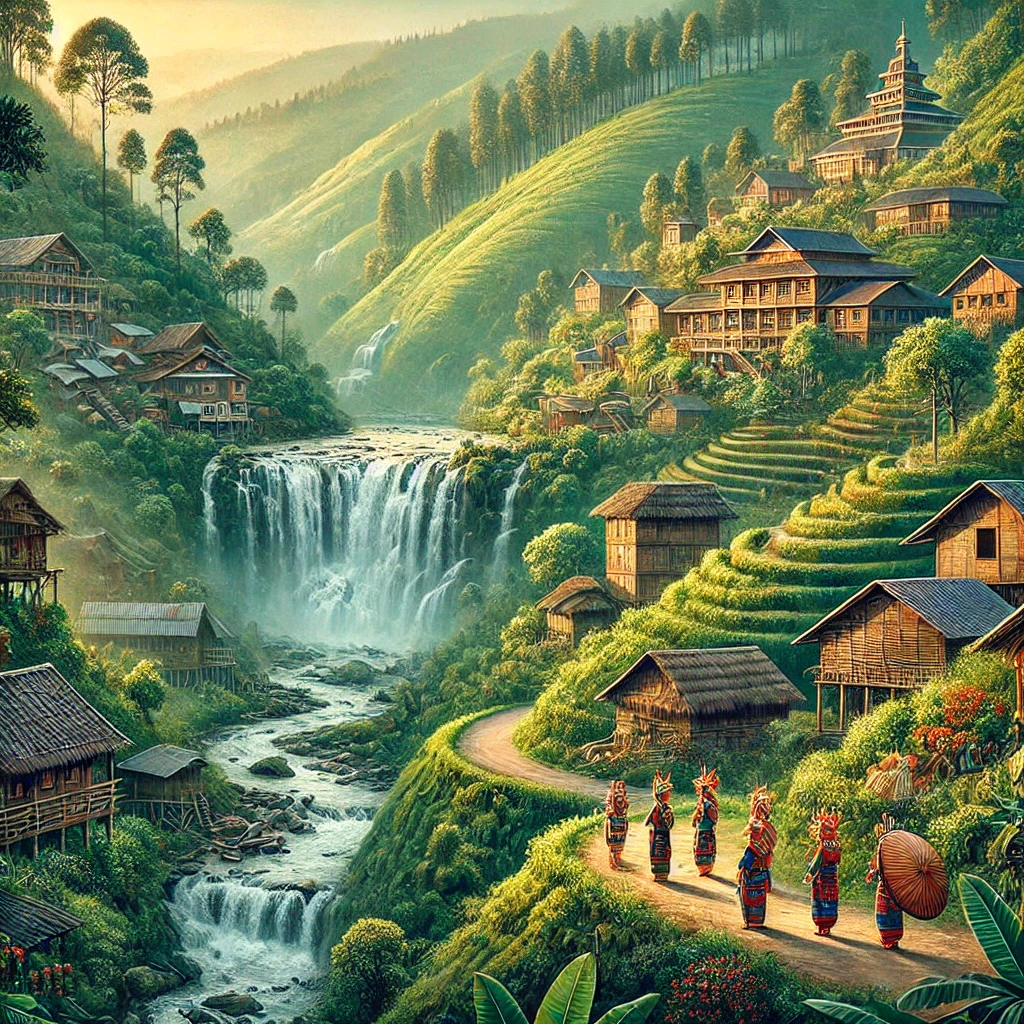
Mizoram is a beautiful and hilly state located in the north – eastern part of India . It is also known as the ” Land of Hills ” . Mizoram is famous for its natural beauty , rich culture and traditions. Let’s get to know about Mizoram in detail.
Geographical location
- The area of Mizoram is 21,081 square kilometers.
- shares its borders with Assam and Manipur to the north , Myanmar and Bangladesh to the south , and Myanmar to the east.
- The major rivers here are Tlang ( Chinghil River ) and Lower Tuirial.
- The capital of Mizoram is Aizawl , which is perched on a hill and located at an altitude of 1,132 m.
History
- Mizoram was earlier part of the state of Assam and was known as ” Lushai Hills ” .
- 1972 it was given the status of a Union Territory.
- 20 February 1987 , Mizoram became the 23rd state of India .
Population and tribes
- is approximately 12 lakhs ( estimated population as of 2021 ) .
- The main tribes here are Lushai , Pawi , Ralte , and Mar.
- About 90% of the population of Mizoram follows Christianity , but people of Buddhist , Hindu , and other religions also live here.
Language
- The official languages of Mizoram are Mizo ( Lushai ) and English.
- Mizo language is the main cultural and social identity here.
Culture and traditions
- Mizo people are known for their rich culture and festivals.
- arc and mim kut These are the major festivals here.
- Mizoram’s traditional dance style ” Cheraw ” ( Bamboo Dance ) is world famous.
- The people here are simple , friendly and peace loving.
Natural beauty and tourism
- The natural beauty of Mizoram makes it a center of attraction for tourists. The greenery , waterfalls and hills here are unique.
- Thengpui Wildlife Sanctuary , Phawngpui National Park , and Vanlawang Falls are major places for tourists.
- Reike Village and Champhai Famous for its traditional architecture and vineyards.
economy
- The economy of Mizoram is mainly based on agriculture.
- Jhum cultivation is prevalent here , which is now being attempted to be transformed into permanent farming.
- The major crops are rice , maize , fruits and vegetables.
- Bamboo and silk industries have developed in recent years.
Politics and administration
- 40 seats in the Assembly in Mizoram .
- The administrative system here is democratic , and the people here actively participate in social welfare.
features
- Mizoram is one of the cleanest states in India.
- is also known for its high literacy rate (91%) .
- People of Mizoram believe in community living and the community cooperation system called ” Zawbkhai ” is very popular here.
Mizoram is a wonderful state due to its natural beauty , cultural diversity and peaceful lifestyle. The traditions and unique lifestyle here make the diversity of India more rich.
Geographical location of Mizoram
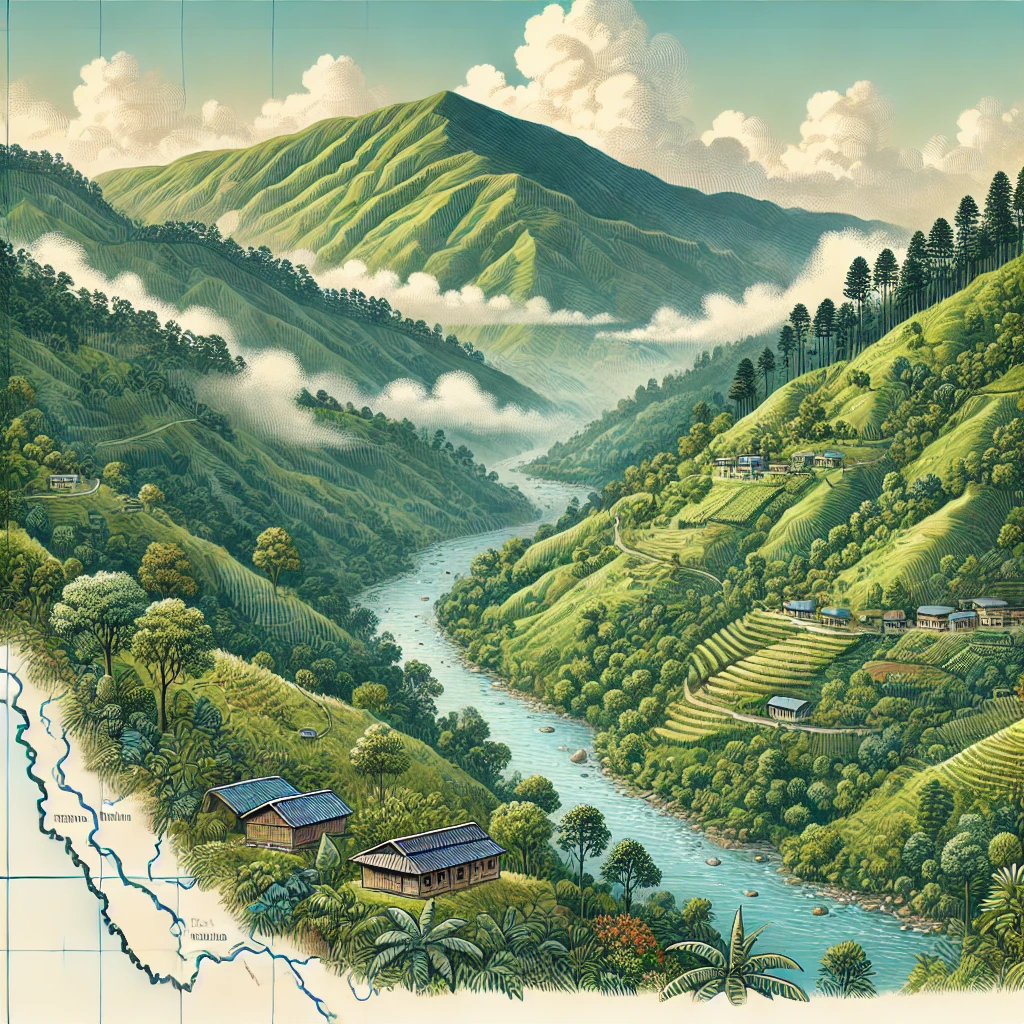
Geographical location of Mizoram is a beautiful and hilly state located in the north – eastern part of India . The state is known for its natural beauty , diverse geography and unique climate. Let us understand the geographical location of Mizoram in detail :
Status and extent
- Mizoram is situated in the foothills of the Eastern Himalayas.
- The state extends between 21°56′ North latitude to 24°31′ North latitude and 92°16′ East longitude to 93°26′ East longitude.
- In the answer : Mizoram shares its border with Assam and Manipur.
- In the south and east : It is adjacent to Myanmar ( Burma ) .
- In the West : It shares its border with Bangladesh.
Area
- The total area of Mizoram is 21,081 square kilometers. Is.
- is approximately 0.64% of India’s total land area .
Mountain geography
- Mizoram is called the “ Land of Hills ” because almost its entire area is surrounded by hills and valleys.
- The hills here are spread from north to south.
- The major hills are :
- Phawngpui ( Blue Mountain ): It is the highest peak in Mizoram , with a height of 2,157 metres.
- Lunglei and Humlang Hills.
Rivers
- Many small and big rivers flow in Mizoram , which are important for agriculture and water sources.
- Major rivers :
- Tlang ( Dhalai ) River : It is the longest river in the state.
- Chinghil River.
- Tuirial , Tuivang, and Tuipui.
- These rivers flow towards Myanmar and Bangladesh and contribute to the irrigation there.
climate
- Tropical climate in Mizoram Is found.
- The summer season is mild and cool , while the winter season is cold but comfortable.
- The average annual rainfall is about 2,500 mm. it occurs.
Vegetation and biodiversity
- 75% of the area of Mizoram It is covered with forests.
- , Sal and various types of flowering plants are found in the forests here .
- This state is unique in biodiversity. Many rare birds , animals and plants are found here.
Earthquake affected areas
- Mizoram falls in the earthquake sensitive zone as it is situated at the junction of the Indian Plate and the Burma Plate.
- Earthquakes of mild to moderate intensity keep occurring here.
Geographical features and significance
- Height and slope : The hills of Mizoram are at an average height of 900 to 1,200 metres above sea level. They are at a height.
- Fertile Valleys : Between the hills are fertile valleys , which are used for agriculture.
- Water Source : The rivers flowing here are important for hydropower and irrigation.
- Natural Resources : Bamboo and wood are the main natural resources here.
Geographic beauty
The geographical location of Mizoram makes it one of the most beautiful states of India. The combination of hills , greenery , valleys and rivers creates a breathtaking landscape here. This place is very important from the environmental point of view , and the environmental balance here makes it unique.
Thus , the geography of Mizoram not only contributes to its natural beauty but also influences its lifestyle , culture and economy.
History of Mizoram
History of Mizoram eastern region of India . The tribes here , their traditions and their struggles make the history of Mizoram unique. Let us understand the history of Mizoram in detail.
Ancient period
- The ancient history of Mizoram is mainly based on oral traditions and tribal tales.
- The major tribes here , such as the Lushai , Pawi , Mar , and Ralte , belong to the Tibeto – Burmese group.
- The Mizo tribes believe that they originally came from China and Myanmar. Came to Mizoram from the border areas of.
- Their migration took place during the 16th and 17th centuries , when these tribes settled in the hilly areas.
Medieval history
- Mizoram was previously ruled by independent tribal communities.
- The Mizo people here lived in small groups under the ” Clan System ” .
- Mizo society was based on ” respectful monarchy ” , where each village was headed by a chief .
- There were internal conflicts and wars over boundaries among the Mizo tribes.
- The life of these tribes was mainly based on agriculture and forest.
British Rule (19th Century )
British Contact :
- The British came into contact with the Mizo tribes in the mid-19th century .
- among the Mizo tribes increased in the 1850s .
Lushai Rebellion :
- 1871–72 the Mizo tribes revolted against the British , which was known as the Lushai Rebellion It was said.
- The main cause of the rebellion was the attempts by British authorities to take control of Mizo land.
- The British army crushed this rebellion and gradually annexed most of Mizoram to British India.
Formation of Lushai Hills :
- 1890s , Mizoram was made part of Assam Province under the name ” Lushai Hills ” .
- 1898 it was officially placed under British rule.
modern history
Missionary influence and the advent of Christianity :
- Christian missionaries arrived in Mizoram in the late 19th century .
- 1894 In 1756 Welsh missionaries started preaching Christianity here.
- The missionaries introduced education and health services , introducing modernity into Mizo society.
- Today , the majority of Mizoram’s population practices Christianity.
Independence of India and Status of Mizoram :
- After India’s independence in 1947 , Mizoram became part of Assam.
- In 1950 it was declared as ” Lushai Hills District ” .
Mizo rebellion and peace agreement :
- 1960s , the Mizo National Front (MNF) demanded independence of Mizoram.
- The Mizo rebellion occurred in 1966 , during which the MNF tried to secede from India.
- The Indian Army launched a massive operation to suppress this rebellion.
- In 1986 , the Mizoram Peace Accord was signed between the Government of India and the MNF .
Union Territory Status :
- 1972 , Mizoram was separated from Assam and made a union territory.
- Laldenga Political stability came under the leadership of Mizo leaders.
Formation of a full-fledged state :
- 20 February 1987 , Mizoram was recognised as the 23rd state of India.
- At this time Laldenga became the first Chief Minister of Mizoram.
Contemporary History of Mizoram
- Mizoram is now one of the most peaceful and clean states of India.
- is the highest in India (91%) .
- The focus in Mizoram’s politics is on stability and development.
The history of Mizoram is a mix of struggle and prosperity. The state is not only known for its traditions and cultural diversity but is also a symbol of peace and development.
Population and Tribes of Mizoram
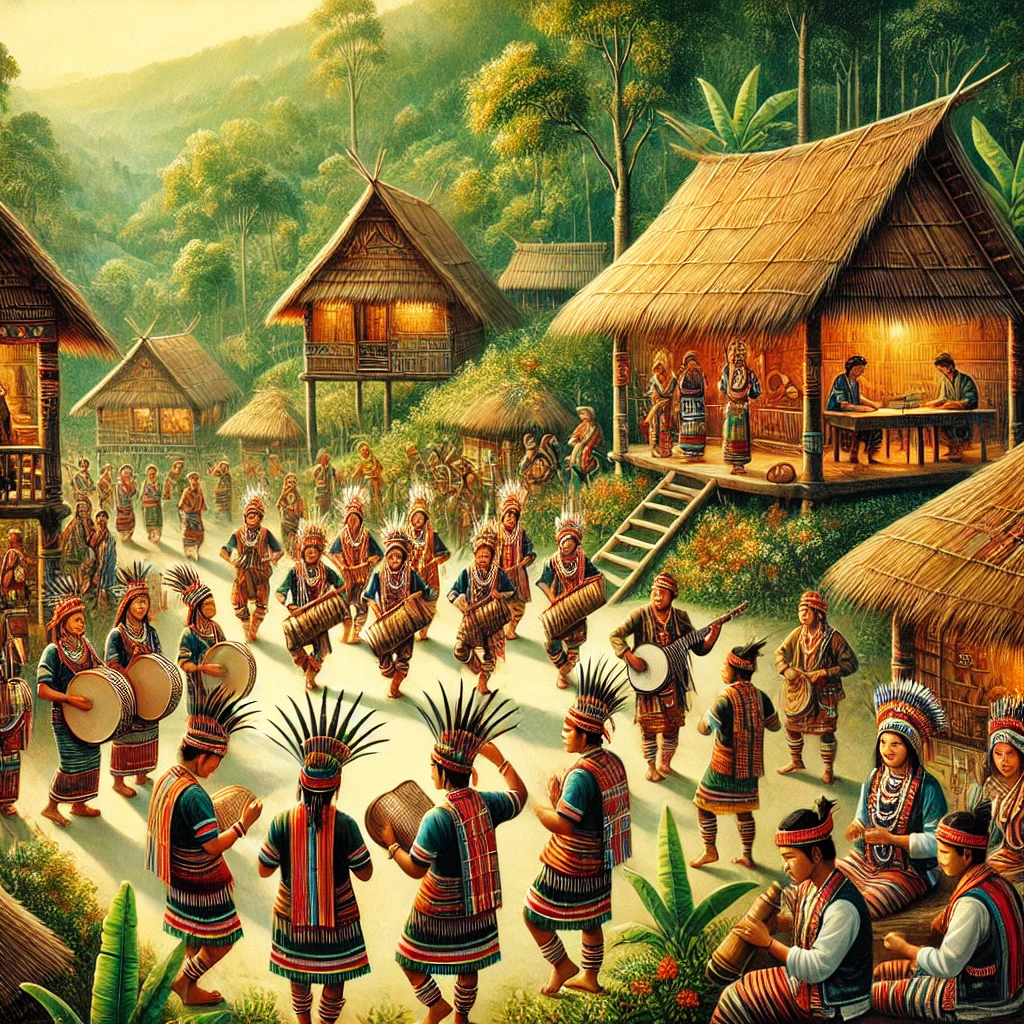
Mizoram is known for its rich tribal culture , traditions and peaceful social life. The population here is mainly divided into various tribes , which make the culture , language and lifestyle of the state unique. Let us get to know in detail about the population and tribes of Mizoram.
Population details
total population :
- Total population of Mizoram ( as per 2021 estimate ) is around 12 lakhs Is.
- According to the 2011 census , Mizoram has a population of 10,91,014 Was.
Sex Ratio :
- Sex ratio of Mizoram is 976 females per 1000 males Is.
Literacy rate :
- The literacy rate of Mizoram is around 91% , which is the highest in India.
- The male literacy rate is 93% and female literacy rate is 89% .
Urban and Rural Population :
- 52% of Mizoram’s population lives in urban areas and 48% in rural areas.
- The state capital is Aizawl It is the largest urban centre.
Classification of tribes
The population of Mizoram is predominantly tribal. More than 90% of the population here belongs to various tribes. The Mizo tribes belong to the Tibeto – Burmese group. The traditions , languages and customs of these tribes are the basis of the cultural identity of the state.
Major tribes :
Lushai ( Mizo ):
- It is the largest and most prominent tribe of Mizoram.
- ” Mizo ” means ” people of the hills ” .
- The society of the Lushai tribe is lineage ( clan based ) .
- are mainly engaged in agriculture , crafts and animal husbandry.
Pawi :
- It is a major sub – tribe of the Mizo tribe.
- The Pavi tribe is found in the southern parts of Mizoram.
- Their customs and traditions are similar to those of the Lushai tribe.
Ralte :
- It is a small but important tribe of the Mizo community.
- Their main occupation is agriculture , and they are famous for their traditional dance and music.
Mara :
- This tribe is found in the southern part of Mizoram , especially in Saiha district.
- Their social and cultural customs are unique.
- The language of the Mar tribe is called ” Mara ” .
Lai :
- This tribe mainly resides in Champhai district.
- is also famous for its dance , music and traditional art.
Other tribes :
- Hmar : Found in northern Mizoram, this tribe is engaged in agriculture and forest-related activities.
- Chakma : This tribe follows Buddhism and inhabits the western part of Mizoram.
- Brew : This tribe is found in the border areas of Mizoram and their cultural traditions are unique.
Language and religion :
Language :
- The main language of Mizoram is Mizo ( Lushai ) Is.
- Other languages include Mar , Pawi , Ralte , and Hmar Are included.
- English is used as the administrative and academic language.
Religion :
- About 87% of the population of Mizoram is Christian believes in.
- The people here are mainly Protestant Christians.
- Other religions include Buddhism ( mainly the Chakma tribe ), Hinduism and a small number of Muslims.
Social Structure and Traditions :
- The society of Mizo tribes is based on community life.
- ” Zawabkhai ” ( community cooperation ) system is an important part of the social life here.
- Clan – based society among tribes Where each village is headed by a Chief .
- their traditions , like the Cheraw dance And Mim Kut festival is a symbol of their cultural heritage.
Lifestyle and Economic Activities :
- The Mizo tribes are mainly engaged in agriculture.
- Traditional Jhum cultivation is prevalent here , which is now being attempted to be transformed into sustainable farming.
- The use of bamboo and wood is very important in daily life.
Importance of Population and Tribes :
The population and tribes of Mizoram symbolize cultural diversity , social harmony and traditional heritage. Their traditions and customs make Mizoram different and unique from other states of India.
Thus , the population and tribes of Mizoram are a fundamental part of the state’s identity.
Language of Mizoram
The languages of the state of Mizoram reflect its cultural and social diversity. The main language here is associated with the traditions and customs of the Mizo community and various tribes. Let us know in detail about the languages spoken in Mizoram.
Major language : Mizo language
- Mizo language It is the most common and official language of Mizoram.
- It is also called ” Lushai ” language.
- The Mizo language belongs to the Tibeto – Burman language family.
- This language is spoken and understood by most of the people of the state.
- , administration and social communication take place in Mizo language .
Other languages
Languages of other tribes are also spoken in Mizoram.
Lai language :
- This language is spoken by the Lai tribe.
- It is mainly practised in and around Champhai district.
Mar language :
- This is the language of the Mara tribe.
- It is spoken in the southern parts of Mizoram , especially the Saiha district.
Pavi language :
- It is the language of the Pawi tribe and is prevalent in Southern Mizoram.
Hmar language :
- This language is spoken by the Hmar tribe in northern Mizoram.
- It is slightly different from the Mizo language.
Chakma language :
- This language is spoken by the Chakma tribe.
- It belongs to the Indo – Aryan language family and is associated with the Chakma community of Bangladesh.
Bru ( Reang ) language :
- This language is spoken by the Bru tribe.
- This language is prevalent in the border areas of Mizoram.
Influence of English
- is a major language of administration , education and business in Mizoram.
- It is also the second official language of the state.
- The influence of English is evident due to the spread of education in Mizoram by Christian missionaries.
Linguistic Diversity and Unity
- Almost every tribe in Mizoram has its own language or dialect.
- However , the Mizo language serves as a lingua franca , uniting all the tribes .
- This linguistic diversity enriches the cultural heritage of the state.
script
- Mizo language is written in the Roman script.
- The tradition was started by Christian missionaries in the late 19th century .
Cultural significance of the language
- The Mizo language and other tribal languages are the medium of their oral traditions , folklore , songs and stories.
- These languages help preserve the identity , history and traditions of the people of Mizoram.
Thus , the languages of Mizoram form the basis of its cultural and social structure. The diversity of these languages makes the identity of the state even more unique.
Culture and Traditions of Mizoram
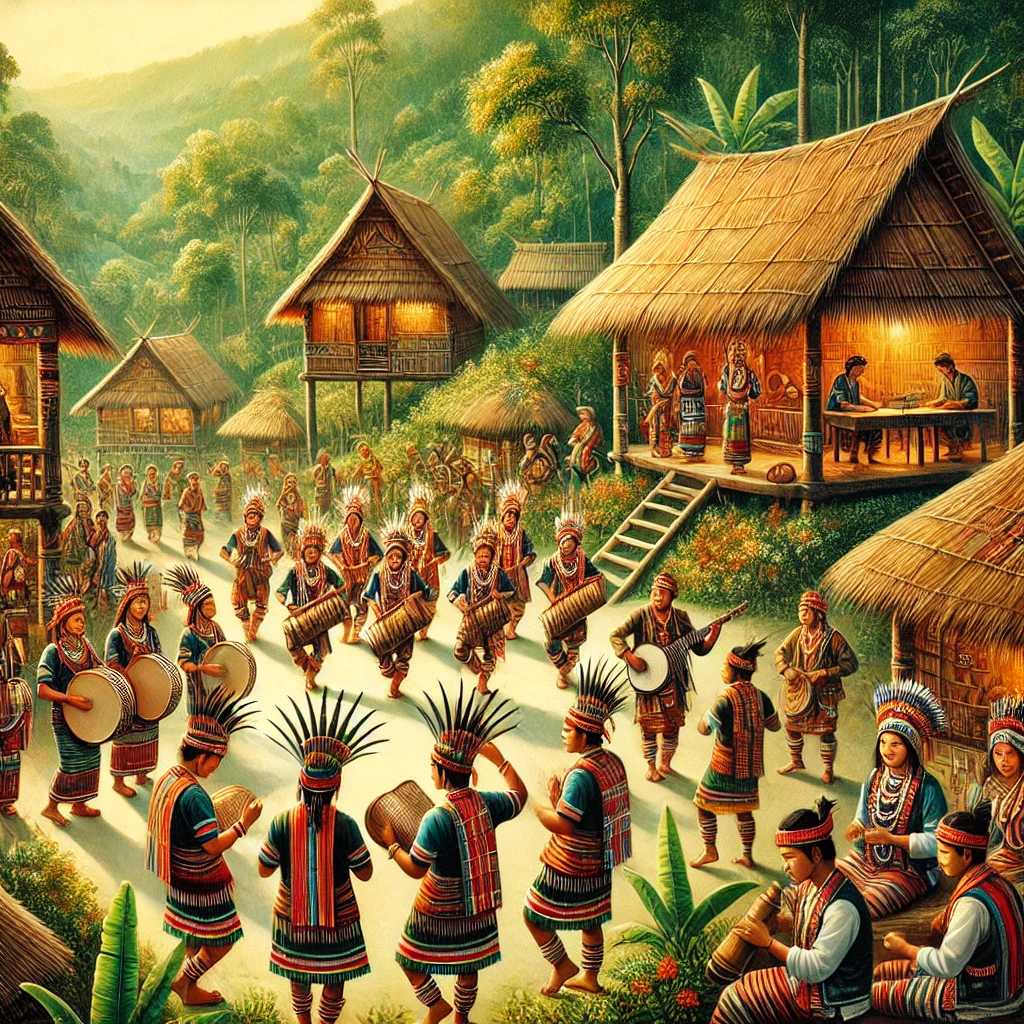
The culture and traditions of Mizoram are rich in its tribal heritage , social structure , festivals and art forms. The state is known for its unique traditions and cultural diversity. Let us understand the major aspects of the culture and traditions of Mizoram in detail.
1. Structure of Mizo society
- Mizo society is based on community life.
- Most of the population of Mizoram is tribal , whose lifestyle is simple and close to nature.
- ‘ Tlawmngaihna ‘ : This is the core social value of Mizo society , which means selfless service , helping others and maintaining community spirit.
- Family is the main unit of Mizo society. In a patriarchal society, the father is considered the head of the family.
2. Outfits and Jewellery
- traditional costume :
- Women ‘ Puanchei ‘ , which is a colourful and beautiful traditional attire .
- ‘ Puan ‘ as male traditional dress wear it.
- Traditional clothes are made from bamboo and cotton weaving.
- The jewellery mainly uses natural materials , such as bamboo and stone.
3. Folk art and music
- Mizoram’s folk art and music are an integral part of its culture.
- Folk songs and dances :
- , nature , courage and community life are prominent in folk songs .
- Folk dances of Mizoram like Cheraw ( Bamboo Dance ) and Kungalam Are famous.
- instrument :
- Mizo music uses bamboo , drums and traditional woodwind instruments.
4. Festivals and Celebrations
are associated with agriculture , community unity and religious faith.
- Chapchar Kut :
- This is the most important festival , which is celebrated before sowing of crops.
- symbolizes dance , music and community feast.
- Mim Kut :
- This festival is celebrated to honour the souls of ancestors after the harvest.
- Paval Kut :
- It is a post-harvest festival , symbolizing community unity and happiness.
5. Religion and religious traditions
- The majority of the population of Mizoram follows Christianity.
- The church is the centre of the cultural and social life of Mizo society.
- Furthermore , the Chakma tribe follows Buddhism , and traditional religious beliefs are prevalent among the Bru tribe.
6. Food and Catering
- The food of Mizoram is simple , nutritious and delicious.
- Main food :
- Rice is the staple food here , which is eaten with fish , meat and vegetables.
- Traditional dishes :
- Maid : A dish made from bamboo shoots , meat and vegetables.
- Champut : Soup of boiled vegetables.
- Zoo : Traditional tea.
7. Architecture
- Mizo houses are made of bamboo and wood.
- Traditional houses are built on hills and are safe from natural disasters.
- A unique combination of nature and beauty can be seen in Mizo architecture.
8. Sports and entertainment
- Traditional games such as Insuknar ( stick fighting ) are popular in Mizoram.
- Among the modern sports, football , volleyball and cricket are popular.
- The people of Mizoram entertain themselves by organizing cultural programs and folk dances.
9. Folk beliefs and customs
- , birth and death in Mizoram are simple and communal.
- The Mizo people respect their ancestors and offer special prayers and worship to them.
- Faith and respect towards nature are prominent in traditional customs .
10. Importance of festivals and traditions
The culture and traditions of Mizoram reflect the social structure , community cooperation and respect for natural life. These traditions make Mizoram a culturally rich state.
Thus , the culture and traditions of Mizoram are a precious part of the tribal heritage and social life here. These traditions reflect the unique identity of the state and contribute significantly to the cultural diversity of the country.
Natural beauty and tourism of Mizoram
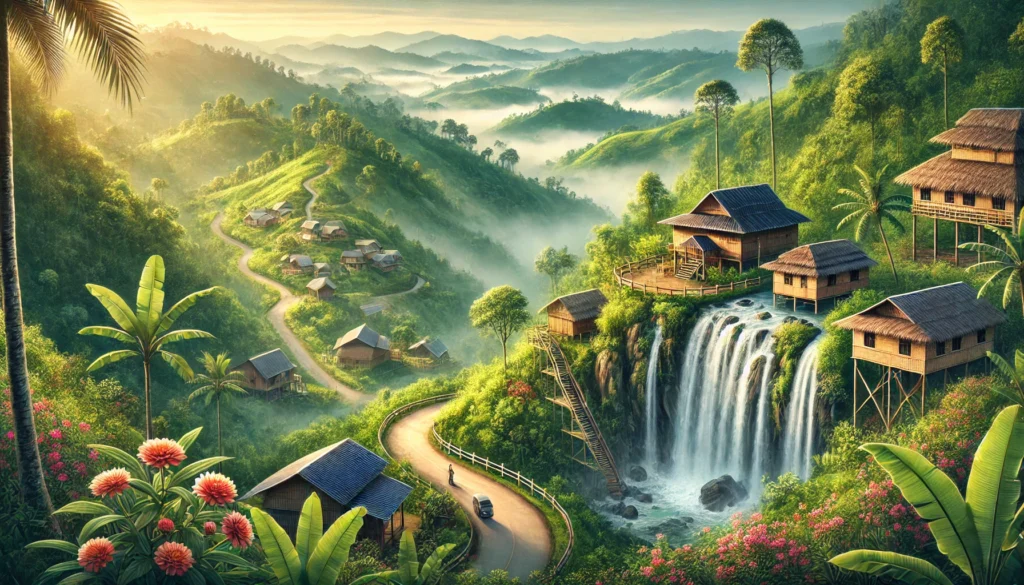
Mizoram is a natural paradise located in the northeastern region of India. The lush green hills , tranquil lakes , enchanting waterfalls , dense forests and colorful flowers make it a center of attraction for nature lovers and tourists. The peaceful environment and tribal culture of Mizoram make it distinct from other tourist destinations.
1. Major attractions of natural beauty
(a) Hills and greenery
- Mizoram is also called the ” Mountain Land of the North-East ” .
- There are more than 21 hills and mountain ranges in the state .
- The rivers and valleys flowing through these hills give it unique beauty.
- Fangpui Mountain ( Blue Mountain ): It is the highest mountain of Mizoram , famous for its natural beauty and biodiversity.
(b) Lakes and rivers
- Palić Lake : This is the largest and famous lake of Mizoram. This lake is known for its calm and picturesque environment.
- Tamdil Lake : There is a man-made lake , which is an ideal place for tourists and fishing enthusiasts.
- Major rivers of Mizoram Chimtuipui and Tuival Which enhances the natural beauty of this place .
(c) Waterfalls
- The waterfalls of Mizoram add to its natural beauty.
- Vantawng Waterfalls : It is the highest and major waterfall of Mizoram , situated amidst lush green forests.
- Lungseng Waterfall and Pukjhung Waterfall There are other famous waterfalls.
(d) Forests and biodiversity
- More than 90% of Mizoram’s area is covered with forests.
- , teak and various medicinal plants are found in the dense forests here .
- Dampa Tiger Reserve : It is the largest wildlife sanctuary of Mizoram , where tigers , elephants , deer and many species of birds are found.
- Mizoram is a paradise for bird lovers.
2. Major tourist destinations
(a) Aizawl :
- Aizawl, the capital of Mizoram, is famous for its scenic views and cultural heritage.
- Major attractions :
- Solomon’s Temple : A magnificent Christian church.
- Dooland Park : This is a beautiful garden , where tourists can enjoy nature.
- Bero Tlang : From here a panoramic view of Aizawl city can be seen.
(b) Champhai :
- This place is known as the ” Rice Bowl ” of Mizoram.
- green valleys and vineyards here attract tourists.
- Rih Dil Lake : Situated on the India – Myanmar border, this lake has historical and religious importance.
(c) Saiha :
- It is located in the southern part of Mizoram.
- The main attraction here is Pali Lake Is.
- Saiha is famous for adventure tourism and fishing.
(d) Vantawng :
- The place is famous for the Vantawng Waterfalls , which draws tourists.
(e) Lunglei :
- It is the second largest city of Mizoram.
- This place is famous for its lush green landscapes and scenic spots .
(f) Hmuifang :
- This place is surrounded by dense forests and greenery.
- It is an ideal place for hiking and camping.
3. Adventure activities in tourism
- Trekking and Hiking : Trekking in the hills and dense forests of Mizoram is an exciting experience.
- River rafting : River rafting is a popular activity on the Tuival River.
- Bird watching : The forests of Mizoram are famous for various species of birds.
- Bamboo Workmanship : Tourists can buy bamboo handicrafts made by local artisans.
4. Cultural tourism
- Visit to Mizo Villages :
- By visiting the traditional villages here, one can closely observe the lifestyle and culture of the Mizo people.
- Cheraw Dance :
- This is a bamboo dance , which is seen in the cultural programs of Mizoram.
- Participation in festivals :
- The culture of Mizoram gets a lively experience during festivals like Chapchar Kut and Mim Kut.
5. Importance of Mizoram tourism
- Tourism in Mizoram not only boosts the economy of the state but also helps in preserving its unique culture and natural heritage.
- Many schemes are being run by the state government to promote tourism , such as road and infrastructure development.
6. Environmental protection in tourism
The people of Mizoram are committed to preserving their natural resources.
- Efforts are being made to convert shifting cultivation into sustainable agriculture.
- Special schemes have been made to promote eco – tourism.
conclusion
The natural beauty and tourism of Mizoram makes it different and unique from other states of India. Lush green hills , lakes , waterfalls , wildlife and rich cultural traditions make Mizoram a unique destination for tourists. This state is an ideal place not only for nature lovers but also for adventure loving tourists.
Economy of Mizoram
The economy of Mizoram is mainly dependent on agriculture , horticulture , forest resources , and trade. The geographical location and natural resources of the state influence its economic activities. The economy of Mizoram is developing at a slow pace , but the people here make a living by making good use of their resources. Let us understand the major sectors of the economy of Mizoram in detail.
1. Agriculture and Horticulture
Main agricultural products :
- Agriculture is the main basis of Mizoram’s economy. The land here is fertile and various types of crops are grown.
- Rice It is the main food crop here and is known as ” Mizo Rice ” .
- Other important crops are maize , wheat , potatoes , tea , ginger , and spices .
- Tobacco and cotton also play an important role in agriculture.
Shifting Cultivation ( Automated Agriculture ):
- Traditional Jhum Farming in Mizoram or shifting agriculture is practiced in which after cultivation at one place , the land is abandoned and cultivated at another place.
- Although Jhum cultivation can have a negative impact on the environment , the state government is trying to transform it into modern and sustainable agricultural practices.
Gardening :
- Mizoram has a significant development in the horticulture sector , especially orange , pineapple , litchi , and papaya Cultivation of.
- Tea and Coffee in the State Horticulture is also done , which contributes to the economy of the state.
2. Industry and craftsmanship
Tree industry and forest resources :
- Mizoram has very rich forest resources. Timber , bamboo , resins , medicinal plants , and other forest products are obtained from the forests here.
- Bamboo Industry It is especially important because Mizoram has a lot of bamboo forests. The local people are skilled in making bamboo products such as baskets , furniture , and paper etc.
Handicrafts and Artisanship :
- Mizoram’s handicraft industry is also important , involving the use of bamboo , wood , and wool Products made from are prominent.
- Seram , Mizo jewellery in the state and coils , and other traditional workmanship are produced.
3. Trade and commerce
- Mizoram Trade It mainly occurs with other states of India and neighboring countries like Bangladesh , Myanmar.
- border trade in the state is also important , especially from Bangladesh and Myanmar.
- Tea and spices trade goes out of Mizoram , and industrial products Products such as paper , wood , and bamboo are also exported.
4. Tourism
- As we saw earlier , tourism sector in Mizoram is also important from the economic point of view.
- Natural beauty , wildlife sanctuaries , and cultural attractions attract tourists , who contribute to the state’s economy.
- Eco – tourism and cultural tourism This is an important step towards the development of Mizoram.
5. Services and Administration
- The sector of services is important for administrative work in state government and central government offices.
- Aizawl is the capital of Mizoram It is the centre of major government offices and other service sectors.
6. Unemployment and employment opportunities in Mizoram
- The unemployment rate in Mizoram is relatively low , but the state is still developing , and employment opportunities need to be increased.
- New employment opportunities are growing in the education , health , tourism , and construction sectors.
- Independence struggle and regional organisation Due to , social welfare schemes in Mizoram and business cooperation are also increasing.
7. Challenges in the state’s economy
- Geographical Barriers : Mizoram’s geographical location and border location pose challenges to economic development.
- Lack of infrastructure : The state lacks good road network and other infrastructure , which affects business and industry.
- Shifting cultivation and environment : Traditional Jhum cultivation affects land fertility , which can lead to a decline in agricultural production.
- Unemployment : As the state is modernizing , unemployment and the need for employment opportunities in the private sector are increasing.
conclusion
Mizoram’s economy is based on agriculture , forest resources , horticulture , handicrafts and services. The state’s natural wealth , especially bamboo , timber and wildlife , contribute significantly to its economic resources. However , Mizoram’s economy also has some challenges , such as lack of infrastructure and traditional agricultural practices , but the state government is paying attention to these issues and implementing various schemes for its development.
Politics and administration of Mizoram
The politics and administration of Mizoram functions as a special state under the Indian Union. The state is headed by a legislature , a chief minister and a governor. Various initiatives are taken in the politics of Mizoram to protect the tribal communities of the state , their rights and culture. Along with this , the structure of government , election process and other administrative aspects also play an important role in the state .
1. Political structure of the state
The political structure of Mizoram is created under the Indian Constitution and it follows a federal system of government. The state government structure mainly consists of the legislature , the executive and the and the judiciary It is based on.
(a) Legislature :
- Legislature of Mizoram by chambers to consist of :
- Legislative Assembly : Legislative Assembly of Mizoram unicameral It consists of 40 members. Out of these, 40 members are directly elected by the people. The term of the Legislative Assembly is 5 years , unless there is some other special situation.
- Council : Legislative Council has not been formed in Mizoram , that is, this state has only one house There is an assembly.
(b) Executive :
- The executive head of Mizoram is the Chief Minister , who elects and elects a Speaker as Speaker of the State Legislative Assembly. Is elected from among the members of.
- Governor : Constitutional head of the state is Governor The head of the state is the Governor , who is appointed by the President of India. The Governor oversees the administrative and constitutional activities of the state , but his role is mostly symbolic.
- Under the leadership of the Chief Minister, the ministers of the state government , who form the majority in the state assembly , work in various fields of administration.
(c) Judiciary :
- The judiciary in Mizoram functions under the Indian judiciary. The decisions of the Supreme Court are followed in all courts of the state.
- High Court in the State is constituted , which is the Gauhati High Court The Gauhati High Court has jurisdiction over Mizoram , Assam and Meghalaya.
2. Major political parties
Political parties in Mizoram The number of parties is limited and state politics is mainly dominated by central parties Local branches and local regional parties The major political parties in Mizoram include :
- Mizo National Front (MNF): It is the main regional political party of Mizoram. This party emphasizes the issues of autonomy of Mizoram and has led the Mizoram government several times. Under the leadership of MNF, Mizoram took steps towards peace under an agreement in 1986 .
- Congress (Indian National Congress): The Indian National Congress has also built a strong political presence in Mizoram. The party has been in power in the state at various times.
- BJP : The Bharatiya Janata Party is also active in the state and has gained political influence in some parts of the state in recent times.
3. Election Process
Elections in Mizoram are conducted by the Election Commission of India. There are three major elections in Mizoram :
(a) Legislative Assembly Elections :
- state assembly elections Elections are held every five years. There are 40 seats in the Vidhan Sabha , and each seat is represented by one candidate.
- Members of the Mizoram Legislative Assembly are directly elected by the people Single priority ballots and election process It takes place under the First Past the Post system .
(b) Lok Sabha Elections :
- One for Mizoram Lok Sabha It is a parliamentary seat. These elections are held every five years and the people of the state directly elect members of the Lok Sabha. The Electoral College elects the Electoral College.
- The Lok Sabha constituency of Mizoram represents the state in the Indian Parliament.
(c) Presidential Elections :
- President of the country by the MLAs of Mizoram Voting is done for , as is done in other states.
4. Political history of Mizoram
The political history of Mizoram is interesting and full of ups and downs. Mizoram’s freedom struggle was also complex , and it took a turning point in the form of the movement of the Mizo National Front (MNF). In 1966 , there was a rebellion in Mizoram , which was led by the Mizo National Front. This rebellion ended when Mizoram was given the status of a state in 1986 . Mila and Mizo National Front signed a peace accord.
5. Special status and territorial rights
Mizoram is included in the Sixth Schedule of the Constitution of India special rights under under which the state enjoys autonomy over its resources , culture and politics The Mizoram government has the authority to take special decisions in state affairs , and the state government is responsible for protecting the rights of tribal communities.
6. State Government Initiatives and Development
Various developmental initiatives are underway in Mizoram , the major ones being :
- Infrastructure and Connectivity : Road and transport are being developed in Mizoram to connect the state with other parts .
- Health and Education : The state government is running many schemes to improve the health and education sectors.
- Financial improvement : Plans are being made for development in the areas of agriculture , tourism and forest products in Mizoram.
conclusion
Mizoram’s politics and administration function as a strong and prosperous system under the Indian Union. The state’s political structure , election process and administrative organization reflect that the government of Mizoram is committed to protecting its culture , natural resources and the rights of tribal communities. The politics here maintains a harmonious balance between regional parties and national parties , and it is constantly striving for the development of the state.
Features of Mizoram
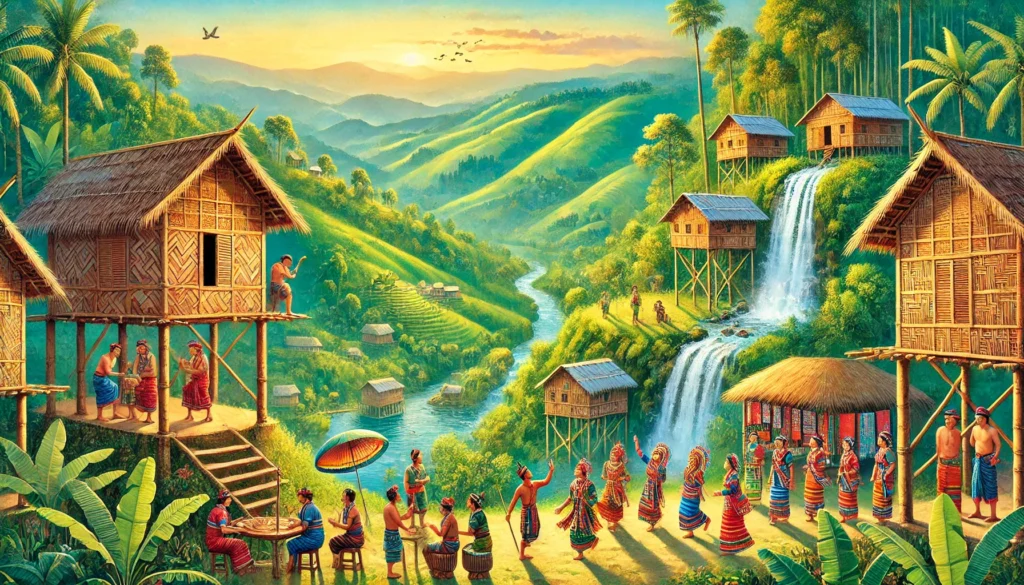
Mizoram , located in the northeastern region of India , is famous for its unique geographical , cultural and social features. The state is attractive for its natural beauty , rich cultural heritage , and tribal lifestyle. Let ‘s take a look at some of the major features of Mizoram :
1. Geographical features
- mountainous areas : Mizoram is completely a mountainous region It is located in. The land of the state is mostly hilly , and it is called the ” land of mountains ” . The height of the hills and dense forests here make it a unique place.
- climate : Mizoram’s climate is northern tropical It has a climate of mild heat in summers and cool in winters. It receives heavy rainfall during the monsoon season , which nourishes its agriculture and vegetation.
- Vegetation and Biodiversity : The state’s forests contain teak , bamboo , and other medicinal plants are found. The biodiversity here is also particularly rich , including a variety of birds , animals , and insects.
2. Cultural characteristics
- Mizo Society : Mizoram is mainly inhabited by Mizo community People of this tribal community live here. This tribal community is very famous for its culture , customs and rituals. and lifestyle It is famous for.
- Language : The official language of the state is Mizo The language spoken is Hindi , and it is mainly spoken among the local people. Apart from this , Hindi and English are also used in education and administration.
- Traditional dance and music : Dance and Music in Mizoram Culture Cherav dance has special significance and the wuhnasaka dance Such traditional dances are part of its cultural heritage.
- Festival : The major festivals in Mizoram include Chapchar Kut , Mim Kut and tulu kut These festivals are related to the agricultural culture , customs and seasons of this place . In these festivals people participate in traditional dances , songs and community feasts.
- Traditional clothing : The people of Mizoram are traditionally from the Thatha , Wantal , and Champhai tribes. Like the clothes they wear , which are part of their cultural identity.
3. Historical features
- Freedom struggle : History of Mizoram British Rule Mizos also actively participated in the freedom struggle .
- Mizo Insurgency : In 1966 a major insurgency broke out in Mizoram , led by the Mizo National Front (MNF) The rebellion was organised by the United Nations in 1986. The rebellion ended with a peace accord in 1986. It ended with , and Mizoram gained Indian statehood.
- 1986 Peace Accord : An important event for Mizoram was the Peace Accord signed in 1986 , under which Mizoram was granted statehood and peace was restored in the state.
4. Economic characteristics
- Agriculture based economy : The economy of Mizoram is primarily agricultural Rice , maize , tobacco , fruits , and spices are the major agricultural products here .
- Forest Resources : Mizoram’s vast forest resources , especially bamboo , timber , and medicinal plants , are important to the state’s economy.
- Bamboo Industry : Bamboo production in Mizoram is very high , and it is used for handicrafts , construction and paper industry It is done in.
- Tourism : The tourism industry is growing rapidly in Mizoram. It is famous for its natural beauty , lakes , waterfalls , and wildlife sanctuaries. attract tourists.
5. Social characteristics
- Education : The level of education in Mizoram is quite high , and the literacy rate in the state is It is much better than other states. The main medium of education is Mizo and English Is.
- Health Care : The condition of health services in Mizoram is better , and many schemes are being run by the state government to expand the health facilities.
- social organization : Social Organizations and Local Communities in Mizoram The role of is important. Many steps have also been taken to protect the rights of women in the state.
6. Administrative and political features
- Special Status : Mizoram is included in the Sixth Schedule of the Indian Constitution It enjoys special status under the Prevention of Cruelty to Animals Act, 1961 , which gives the tribal communities here the right to protect their resources and culture.
- state government : An assembly in Mizoram and the Chief Minister There is a government of the state which runs the administration of the state.
- Mizo National Front (MNF): It is a major political party which plays a major role in the state politics.
7. Environment and natural resources
- Dense forests : More than 90% of Mizoram’s area is covered with forests. The bamboo forests here and vegetation It is rich in biodiversity.
- Climate and rainfall : Mizoram receives heavy rainfall and has an ideal climate. The state is rich in natural resources It is rich in natural resources and is also rich from environmental point of view.
- wildlife Reserve : There are many wildlife sanctuaries in Mizoram and Tiger Reserve Which protect the environment and biodiversity here .
conclusion
The characteristics of Mizoram make it different and unique from other states. The state is famous for its geographical structure , cultural heritage , historical events , and rich natural resources. Mizoram is developing through agriculture , forest industry , tourism , and social reforms , and the state is moving towards prosperity while maintaining its cultural and traditional values.
